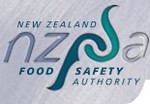Foodborne illness does not come cheap
A new study commissioned by MAF has put the economic cost of the major foodborne infections in New Zealand last year at $162 million – almost twice the figure calculated five years ago.
The increase is not due to more illness, but more reliable estimates of economic cost.
The study calculated the total cost to New Zealand society from illness caused by foodborne Campylobacter, Salmonella, Listeria, E. coli, Yersinia and norovirus in 2009. It takes into account costs to government of regulation and surveillance, business implications and costs, treatment costs, household costs, and costs associated with lost days of work.
MAF public health principal adviser Donald Campbell says the last estimate for 2005 contained a number of uncertainties and data limitations and the new figure is nearer the true total cost to the country.
“This paints a picture that foodborne illness isn’t trivial. Maybe for the individual who gets a couple of days upset it might not seem like a big deal, but for some people it’s very serious – even deadly – and for the country as a whole it’s a major cost,” he says.
Having reliable estimates of both the incidence of foodborne illness and its financial impact are crucial for deciding where to best concentrate effort, time and money in combating foodborne illness, Dr Campbell says.
“Knowing the size of the problem helps in assessing the effectiveness and efficiency of any changes in food standards and regulations that target specific causes of foodborne illness.”
Dr Campbell says the Campylobacter Risk Management Strategy is a notable example of how a concerted effort by Government and industry to bring down the rates of foodborne campylobacteriosis can greatly reduce the financial burden of foodborne illness. The Government has so far contributed $1 million annually to this programme and the poultry industry has spent a further $2.25 million each year.
“There is good scientific evidence that the strategy has been responsible for halving the annual number of campylobacteriosis cases between 2006 and 2009, with an economic saving in the order of $40 million annually.”
Dr Campbell says New Zealand’s overall annual cost of foodborne disease per capita may appear low compared with Australia or the United States. However, he cautions against comparing New Zealand to other countries as a number of factors might be different.
“By and large our outcomes are better as we don’t seem to see the large numbers of complications and even deaths that some countries struggle with, and our healthcare costs are also much lower.”
Ends
EDITOR’S NOTE:
The study – carried out by Applied Economics – takes into account the economic impact of six foodborne illnesses: campylobacteriosis, salmonellosis, norovirus, yersiniosis, STEC and listeriosis. All these diseases may spread through eating contaminated food products and – apart from norovirus – are all bacterial infections.
Of the $133.2 million attributable to individual diseases, an estimated 38% was attributable to norovirus. Campylobacteriosis amounted to 27% of all disease-specific costs, followed by salmonellosis (12%) and listeriosis (11%). Despite the relatively low number of listeriosis cases, it has a high cost per case which is augmented by its potential for serious complications and its high risk of premature death. Yersiniosis is the least costly of the six diseases.
The full report can be found at:
Estimating the Economic Cost of Foodborne Disease in New Zealand
